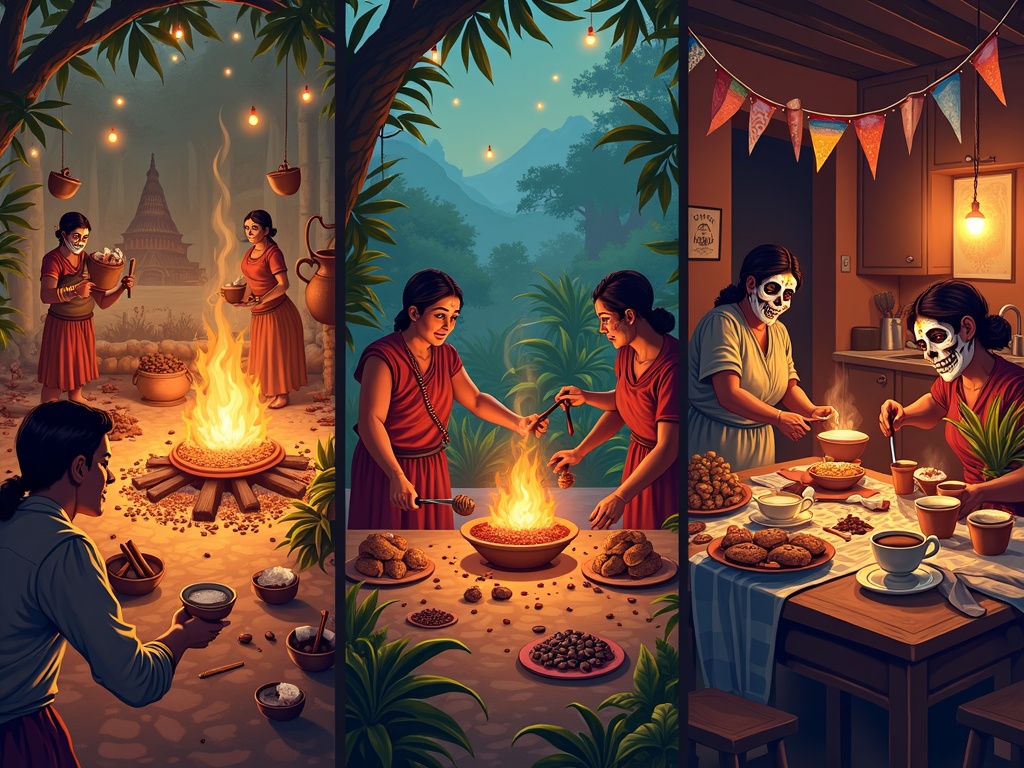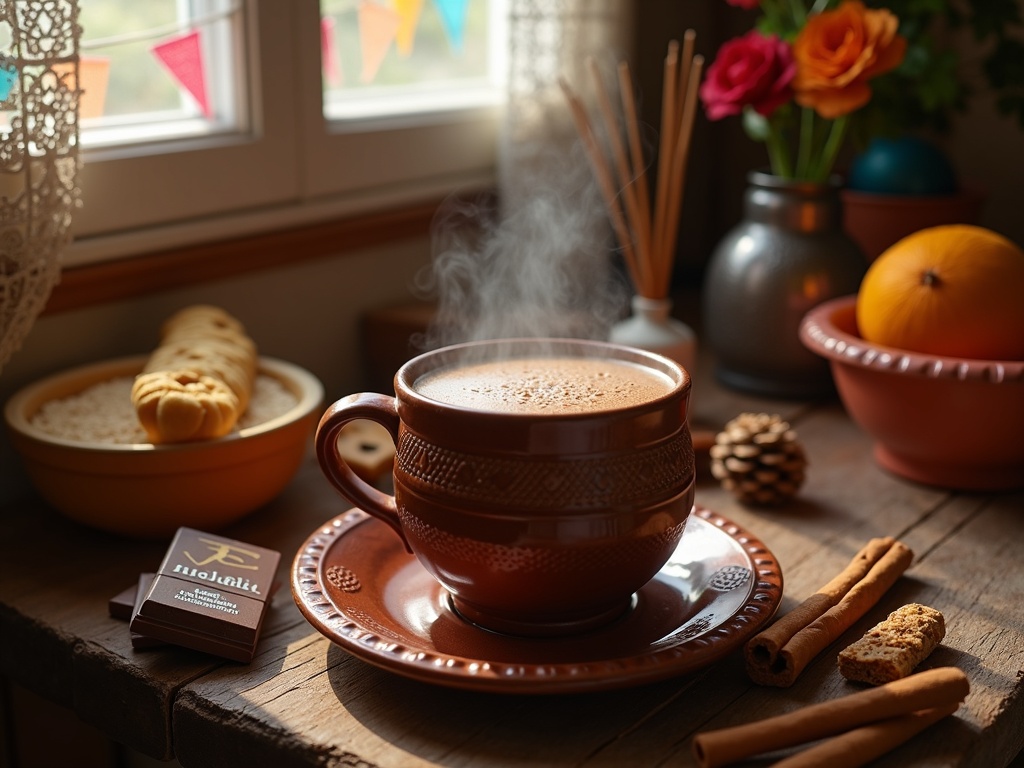Champurrado recipe, a traditional Mexican chocolate drink, blends rich Mexican hot chocolate with masa harina to create a uniquely thick, warming beverage that’s substantial and satisfying. This centuries-old recipe connects ancient Mesoamerican traditions with today’s comfort, offering a distinct alternative to regular hot chocolate with its silky texture and complex flavor profile.
Find In This Article
Key Takeaways
- Masa harina (corn flour) is the essential ingredient that gives champurrado its signature thick texture and distinguishes it from regular hot chocolate.
- Authentic champurrado requires Mexican chocolate tablets like Abuelita or Ibarra, which contain cinnamon and spices for traditional flavor.
- The drink holds cultural significance in Mexican celebrations, particularly during Day of the Dead and Las Posadas Christmas festivities.
- Proper preparation requires patience and continuous stirring to achieve the perfect consistency without lumps or scorching.
- Regional variations exist throughout Mexico, with differences in thickeners, sweeteners, and spice profiles creating unique family recipes.
What Makes Champurrado Recipe Special
Champurrado stands out in the world of hot beverages as a truly unique drink that combines the rich depth of Mexican hot chocolate with the heartiness of masa harina. This isn’t your ordinary hot chocolate – it’s a thick, warming drink that feels like a meal in itself.
A Celebration in a Cup
The magic of champurrado lies in its distinctive texture. Unlike regular hot chocolate that’s simply milk and chocolate, champurrado gets its signature thickness from masa harina – the same corn flour used to make tortillas. This creates a drink that’s substantial and satisfying, perfect for cool mornings when you need something that will warm you from the inside out.
I’ve found that champurrado holds a special place in Mexican cultural celebrations. During the colorful Day of the Dead festivities, families serve this warm drink alongside pan de muerto (bread of the dead). The combination of chocolate, masa, cinnamon, and sometimes anise creates a flavor profile that’s both familiar and distinctly festive.
During the Christmas season, champurrado becomes part of Las Posadas celebrations, where it’s often served with tamales. The drink’s ability to complement savory Mexican dishes while satisfying sweet cravings makes it versatile for holiday gatherings.
What Sets Champurrado Apart
- The corn masa creates a silky, substantial texture that coats your mouth
- Traditional preparation often involves stirring with a molinillo (wooden whisk)
- The drink balances sweetness with earthy corn notes
- It’s typically spiced with cinnamon and sometimes anise or vanilla
- The thickness allows it to be a light meal on its own
I appreciate how champurrado connects to ancient Mesoamerican traditions. The Aztecs and Mayans consumed chocolate drinks (though unsweetened and often cold) for centuries before Spanish colonization brought the addition of sugar and dairy. This historical depth adds another layer to the experience of enjoying this sweet treat that bridges ancient traditions with contemporary comfort.
Whether you’re experiencing champurrado for cultural reasons or simply looking for a more interesting alternative to standard hot chocolate, this unique drink delivers warmth, flavor, and satisfaction like nothing else.
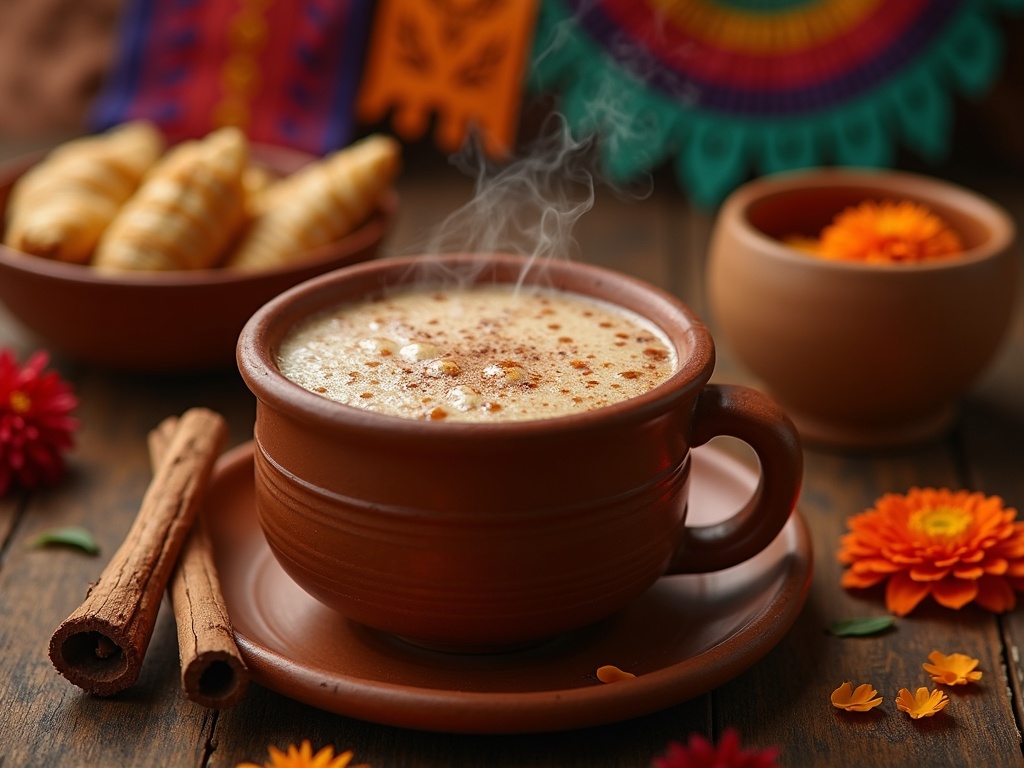
Everything You Need to Make Champurrado Recipe
Gathering all the right ingredients is crucial for creating an authentic champurrado that delivers that perfect balance of chocolate richness and comforting masa thickness. I’ve put together a complete list of everything you’ll need for this traditional Mexican chocolate drink.
Core Ingredients
The foundation of any good champurrado starts with quality ingredients that honor its Mexican heritage. Each component plays a specific role in creating that velvety texture and deep flavor profile.
- 4 cups water – This forms the base of your champurrado.
- 1/2 cup masa harina – This corn flour thickens the drink and gives it its signature texture.
- 2 Mexican chocolate tablets – Look for brands like Abuelita or Ibarra for authentic flavor.
- 2 cups whole milk – Adds creaminess that balances the chocolate intensity.
- 1/2 cup piloncillo (or brown sugar as a substitute) – Mexican unrefined cane sugar that adds caramel notes.
- 1 cinnamon stick – Infuses warm spice throughout the drink.
- Vanilla extract (optional) – A few drops can enhance the chocolate flavor.
The masa harina is particularly important as it’s what separates champurrado from regular hot chocolate recipes by giving it that distinctive thickness and earthy undertone.
Equipment Considerations
Beyond ingredients, you’ll need a few basic tools to prepare your champurrado properly. A traditional molinillo (wooden whisk) is ideal for creating froth, but a regular whisk works too. I find that a medium-sized, heavy-bottomed pot helps prevent scorching, which can ruin the delicate flavors.
When shopping for Mexican chocolate tablets, don’t be surprised to find they contain cinnamon and other spices already mixed in. This adds authenticity to your champurrado and pairs beautifully with other Mexican dishes during celebrations or cold weather gatherings.
The piloncillo cone adds a depth of flavor that regular brown sugar can’t quite match, though the latter makes an acceptable substitute. For an even more indulgent version, some regions add a touch of vanilla or substitute some of the water with more milk for an extra creamy dessert-like drink.
I always keep these ingredients on hand during the colder months, as champurrado makes for a perfect warming treat that connects me to centuries of Mexican culinary tradition.
Step-by-Step Preparation
Creating the perfect champurrado requires patience and attention to detail. I’ve broken down this traditional Mexican chocolate drink into simple steps anyone can follow at home.
Creating the Base
First, I take approximately ¼ cup of masa harina and gradually dissolve it in about 1 cup of warm water. This step is critical – I work carefully to create a smooth mixture without any lumps, whisking continuously until the consistency resembles a thin porridge. The masa harina gives champurrado its distinctive thick texture that sets it apart from regular hot chocolate recipes.
Next, I transfer this mixture to a medium-sized pot over medium heat. This requires constant attention – I stir continuously to prevent the bottom from scorching or forming lumps. The mixture will begin to thicken slightly during this process.
Adding the Flavor Elements
Once my base has heated through, I add the key flavor components that make champurrado so special:
- Chocolate: I break a tablet of Mexican chocolate (or dark chocolate with a touch of cinnamon) into small pieces and add it to the pot, stirring until completely melted.
- Piloncillo: About 3–4 ounces of grated piloncillo goes in next. If unavailable, brown sugar works as a substitute, though it lacks some of the molasses notes that make traditional Mexican dishes so distinctive.
- Cinnamon: I add a whole cinnamon stick or ½ teaspoon of ground cinnamon for that warm, aromatic spice element.
After these ingredients have incorporated, I gradually pour in 3–4 cups of milk, stirring constantly. Some recipes call for a mix of milk and water, but I find using all milk creates a richer, more satisfying dessert beverage.
The final crucial step involves simmering the mixture for about 10–15 minutes, whisking frequently until it reaches the perfect thickness. The champurrado should coat the back of a spoon but still pour easily. For the smoothest texture, I sometimes strain the finished drink through a fine-mesh sieve before serving, though many enjoy the traditional slight texture from the masa.
Serve this comforting drink hot in mugs, perhaps with a cinnamon stick garnish or a light dusting of ground cinnamon on top for an extra touch of flavor and visual appeal.
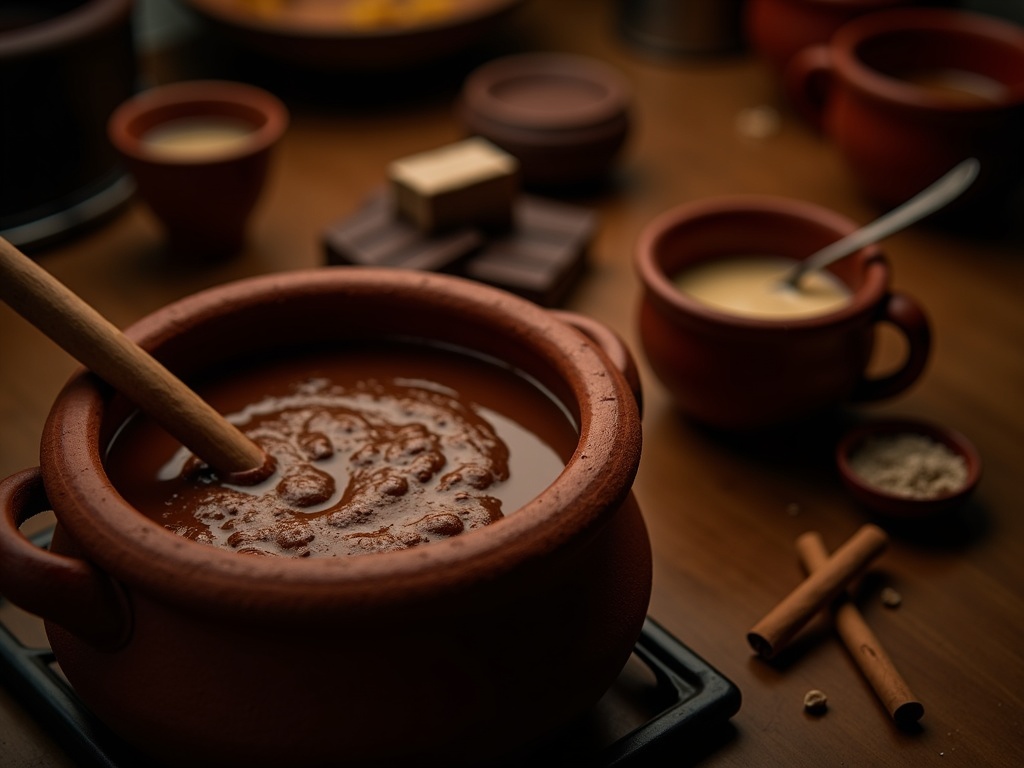
Common Mistakes to Watch For
Creating the perfect champurrado requires attention to detail. After making countless batches over the years, I’ve identified several pitfalls that can turn your rich, velvety Mexican chocolate drink into a disappointing experience. By avoiding these common errors, you’ll master this traditional beverage in no time.
Ingredient and Preparation Errors
Using cold water to dissolve masa harina is perhaps the most frequent mistake beginners make. Cold water causes the masa to clump, resulting in a lumpy texture that’s difficult to fix later. Instead, I always use warm water and whisk thoroughly until the mixture is completely smooth before adding it to the pot.
Another critical error is using the wrong type of chocolate. Authentic champurrado requires Mexican chocolate discs like Abuelita or Ibarra, not regular cocoa powder or baking chocolate. These special chocolate discs contain cinnamon and sometimes other spices that give champurrado its characteristic flavor. If you’re looking for other warm, comforting beverages, you might enjoy a classic hot chocolate recipe as an alternative, though it won’t have the same texture or traditional flavor profile.
I’ve noticed many people add all ingredients at once, which is a recipe for disaster. The process should be sequential:
- First dissolve the masa in warm water
- Then bring the milk to a gentle simmer
- Only then add the chocolate and piloncillo (or sugar)
- Finally, add spices like cinnamon or anise
Adding ingredients in the wrong order can prevent proper thickening or result in uneven flavor distribution throughout your champurrado.
Process and Timing Issues
Not stirring continuously ranks high on my list of champurrado mistakes. This drink requires constant attention as it cooks. When left unattended, it can develop a skin on top, stick to the bottom of the pot, or form lumps that are impossible to smooth out. I use a wooden molinillo (traditional Mexican whisk) for the most authentic results, but a regular whisk works well too.
Rushing the thickening process is tempting but counterproductive. Authentic champurrado needs time to develop its signature velvety consistency. I’ve found that at least 15–20 minutes of gentle simmering is necessary. Increasing the heat to speed this process will likely result in burning or an inconsistent texture.
Many champurrado novices underestimate the importance of temperature control. The mixture should never reach a rolling boil—just a gentle simmer. Boiling can cause the masa to cook too quickly, resulting in an unpleasant gritty texture instead of the smooth, rich consistency that makes great champurrado special.
If you’re exploring Mexican culinary traditions, champurrado is often served alongside sweet bread or as part of holiday celebrations. It pairs wonderfully with traditional Mexican dishes and can be the perfect ending to a festive meal.
When prepared correctly—avoiding these common pitfalls—champurrado offers a uniquely satisfying experience that connects you to centuries of Mexican culinary tradition. The combination of chocolate, masa, and spices creates a warming, nourishing drink that’s perfect for cool evenings or morning celebrations. For those with a sweet tooth, it’s a delightful alternative to desserts while still satisfying cravings for something rich and comforting.
Tips for Perfect Champurrado
Getting that perfect cup of champurrado requires attention to a few key details. I’ve found that making small adjustments to your technique can transform this traditional Mexican chocolate drink from good to exceptional. Let me share some practical advice to help you create the most delicious champurrado possible.
Ingredients and Preparation
Choosing the right chocolate makes all the difference in achieving an authentic flavor profile. I always use Mexican chocolate tablets rather than regular cocoa powder or chocolate chips. These tablets contain cinnamon and sometimes other spices that give champurrado its distinctive taste. They’re readily available in Mexican grocery stores or in the international section of many supermarkets.
Texture is crucial for a satisfying champurrado experience. After cooking, I recommend straining the mixture through a fine-mesh sieve to remove any masa harina lumps. This extra step creates a smoother, more velvety drink that’s much more enjoyable to sip.
The perfect consistency varies based on personal preference. If your champurrado becomes too thick (which often happens as it cools), you can easily adjust by adding more milk or water until you reach your desired thickness. Add the liquid gradually—a tablespoon at a time—while stirring continuously.
Storage and Reheating
Made too much? Don’t worry! Champurrado stores beautifully in the refrigerator for up to three days. I store leftovers in an airtight container to maintain freshness.
When reheating, gentle heat is key. I warm it slowly on the stovetop over medium-low heat rather than using high heat, which can cause scorching. Stir frequently during reheating to prevent the bottom from burning. The mixture will likely thicken in the refrigerator, so you’ll need to add a splash of milk or water while reheating to restore the original consistency.
For a special twist on your hot chocolate drink, try garnishing your champurrado with a cinnamon stick or a sprinkle of ground cinnamon on top. This not only enhances the flavor but also makes for a beautiful presentation when serving to guests.
These simple adjustments can elevate your champurrado to new heights, making it a perfect addition to your collection of Mexican dishes to enjoy during cool weather or special celebrations.
Serving Suggestions
I always pour champurrado into ceramic mugs while it’s steaming hot to preserve its rich warmth and allow guests to fully appreciate its aromatic qualities. The thick, chocolatey texture deserves proper presentation to enhance the overall drinking experience.
Traditional Pairings
Champurrado naturally complements traditional Mexican baked goods and savory dishes. Consider these classic pairings:
- Pan dulce – The sweetness of Mexican sweet bread, especially conchas with their sugar-shell topping, creates a perfect balance with the earthy chocolate tones of champurrado
- Tamales – The contrast between savory corn masa and the sweet, chocolate drink makes for a traditional Mexican breakfast pairing
- Churros – The crispy, fried texture dipped into velvety champurrado offers a delightful textural contrast
For authentic presentation, I place a cinnamon stick directly in each mug. This isn’t just decorative—it continues to infuse subtle spice notes as your guests enjoy the drink and serves as a natural stirrer for the thick beverage.
Modern Interpretations
While respecting the traditional recipe, I’ve found some contemporary serving options that add visual appeal without compromising authenticity. A dollop of freshly whipped cream creates a luxurious appearance and adds a creamy component that slowly melts into the rich hot chocolate base.
Champurrado works wonderfully as both a morning and evening drink. I serve it for breakfast paired with something simple like toast or fruit, while evening servings call for more substantial pairings like cookies or cake. The warming properties and filling nature of this drink make it suitable throughout the day, especially during colder months.
When serving champurrado for special occasions, I sometimes create a full dessert experience by offering a small plate of Mexican wedding cookies (polvorones) or shortbread alongside each mug for guests to alternate between sips of the warm drink and bites of crumbly cookie.
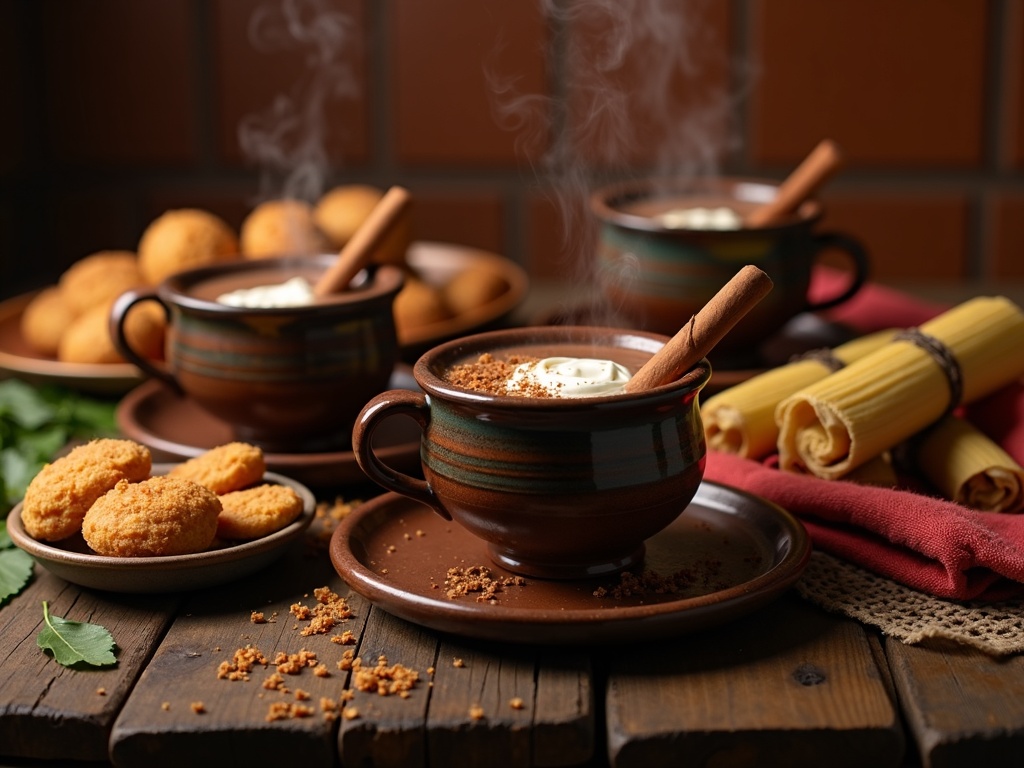
Traditional Variations
Champurrado, a rich Mexican chocolate drink, varies significantly across regions and families. I’ve discovered that authentic recipes differ greatly depending on local traditions and personal preferences.
Regional Ingredients and Thickeners
The foundation of champurrado often changes based on geography. While masa harina (corn flour) serves as the traditional thickening agent in most recipes, some regional variations use alternatives:
- In Oaxaca, they often use pinole (toasted corn flour) instead of regular masa harina
- Some Veracruz families prefer rice flour for a lighter texture
- Northern regions sometimes use wheat flour when corn isn’t readily available
The type of chocolate used also creates distinct regional flavors. Some areas insist on using locally produced chocolate tablets while others incorporate specialized hot chocolate varieties with different cacao percentages.
Family Recipe Distinctions
Family recipes passed through generations often include unique touches that make each champurrado special. The spice profile can vary dramatically:
- Some add star anise for a complex licorice note
- Others might include a pinch of cloves or allspice
- Cinnamon is nearly universal, but the amount and type (Ceylon vs. Cassia) differs
The sweetness level is perhaps the most personal aspect of champurrado. Some households prefer a barely sweet version that highlights the chocolate’s natural bitterness, while others add generous amounts of piloncillo or brown sugar. This explains why sampling champurrado from different Mexican dishes vendors can be such a varied experience.
Liquid bases also differ significantly. Traditional recipes often use a combination of milk and water, but some versions skip milk entirely. These water-based versions tend to be lighter but still maintain the characteristic thickness through the masa harina. Some modern adaptations even incorporate plant-based milks for those avoiding dairy.
The beauty of champurrado lies in these variations – no two recipes are exactly alike, yet all share that comforting, thick chocolate character that makes this dessert beverage so beloved across Mexico and beyond.
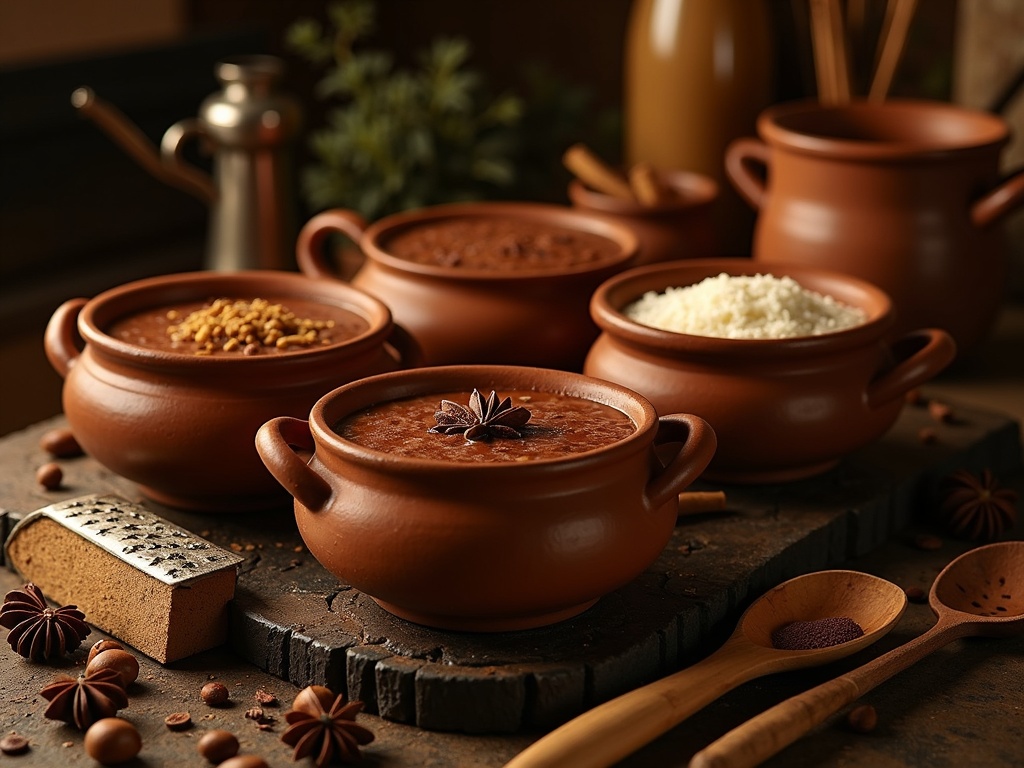
Champurrado History
Champurrado holds a special place in Mexican culinary tradition with roots stretching back centuries to pre-Columbian times. This thick, chocolate-based drink has evolved significantly while maintaining its cultural importance as a beloved comfort beverage.
From Aztec Origins to Modern Favorite
The story of champurrado begins with the ancient Aztecs, who first created a precursor to this beloved drink. The Aztecs developed a beverage called “xocolātl,” a mixture of cacao beans, water, and sometimes chili peppers. Unlike today’s sweet version, this original drink was bitter and often consumed by nobility and warriors for strength and energy.
After the Spanish conquest of Mexico in the 16th century, this ancient chocolate drink underwent significant transformation. The Spanish introduced sugar and milk to the native chocolate preparations, gradually creating a sweeter profile more familiar to European tastes. This cultural fusion marked the beginning of champurrado’s evolution into the drink we recognize today.
What truly distinguishes champurrado from other hot chocolate varieties is the addition of masa harina (corn flour), which gives the drink its characteristic thick, almost porridge-like consistency. This corn component connects the beverage directly to Mesoamerican agricultural traditions, where corn was considered sacred.
Throughout Mexican history, champurrado has been closely associated with celebrations and religious observances. It’s traditionally served during Día de los Muertos (Day of the Dead) and Las Posadas (the nine days leading up to Christmas). During these festivities, families gather to enjoy this warming drink alongside tamales, creating memorable communal experiences that strengthen cultural bonds.
Traditional Preparation and Modern Adaptations
The traditional preparation of champurrado involves several key steps that have been passed down through generations. Historically, cooks would use a molinillo, a wooden whisk with movable rings, to create the froth characteristic of well-made champurrado. This tool is rolled between the palms while inserted in the pot, creating a light foam on the surface of the drink.
Authentic preparation begins with dissolving masa harina in water to create a slurry. Meanwhile, Mexican chocolate (which contains cinnamon and sometimes almonds) is melted separately. The two mixtures are combined with piloncillo (unrefined cane sugar), additional cinnamon, and sometimes vanilla or anise, then simmered until thick and aromatic.
In recent decades, champurrado’s popularity has extended beyond Mexico’s borders. The drink now appears in specialty coffee shops and Mexican restaurants throughout the United States and internationally. Modern adaptations include:
- Dairy alternatives like almond or oat milk for vegan versions
- Premium chocolate varieties for more complex flavor profiles
- Ready-mix preparations for convenience
- Bottled and canned versions for commercial distribution
- Frozen adaptations as dessert options
Despite these innovations, many families still prepare champurrado using recipes handed down through generations, particularly during holiday seasons. The ritualistic preparation of this drink connects modern Mexicans to their ancestral heritage while allowing for personal and regional variations.
Today, champurrado stands as a delicious symbol of cultural resilience and adaptation. What began as a sacred Aztec beverage transformed through colonial influence, yet maintained its essential character and importance. The drink’s journey from pre-Columbian ritual to beloved modern comfort food illustrates how culinary traditions can preserve cultural identity while embracing change. For those exploring Mexican desserts and beverages, champurrado offers a taste experience deeply connected to centuries of history.
